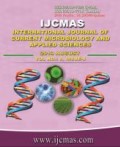


 National Academy of Agricultural Sciences (NAAS)
National Academy of Agricultural Sciences (NAAS)

|
PRINT ISSN : 2319-7692
Online ISSN : 2319-7706 Issues : 12 per year Publisher : Excellent Publishers Email : editorijcmas@gmail.com / submit@ijcmas.com Editor-in-chief: Dr.M.Prakash Index Copernicus ICV 2018: 95.39 NAAS RATING 2020: 5.38 |
Tomato crop affected by different fungal diseases in which Fruit rot known as target spot disease incited by Sclerotinia sclerotiorum is one of the most destructive disease. Disease severity varied (30.50 to 18.60%) in different locations of Kanpur. Highest disease severity was (30.50%) and the lowest disease severity (18.60%) was noticed at the farmer’s field of Billhore, Kanpur. Sclerotinia sclerotiorum is a soil borne pathogen which causes symptoms on ripe fruits. Pathogen isolated from infected fruits. Copper oxychloride, Kavach, Tebucanazol, Andrachite, Dithane M-45, Metalaxyl, Roko and Bavistin completely suspected the growth of pathogenin vitro. Among eight fungicides, Tebuconazol, Andrachite, Metalaxyl, Roko, and Bavistin were found effective against pathogen under in vitro and in vivo conditions. However, seven bio-agents (Trichoderma spp.), T. koningii, T. virensare found effective in bothconditions. In vitro eight fungicides were tested against pathogen in which Metalaxyl, Roko, Tebucanazol, Andrachite and Bavistin showed 100% growth inhibition. Seven bio-agents (Trichodermaspp.) were tested in vitro while, among them T. koningii showed maximum inhibition followed by T. virens, T. longibrachiatum, T. atroviridae, T. asperallum, T. viridae and T. reesei, respectively. Eight treatments were applied in vivo for disease management however, among them T6 (Bacillus subtilis + bavistin) recorded the minimum disease incidence and maximum fruit yield.
 |
 |
 |
 |
 |